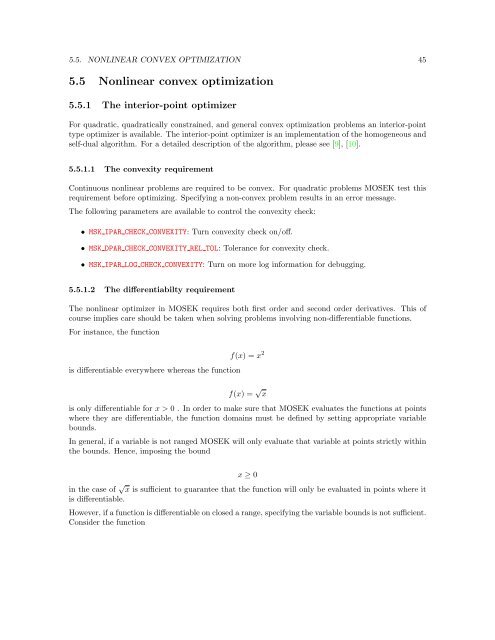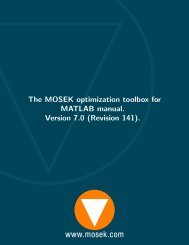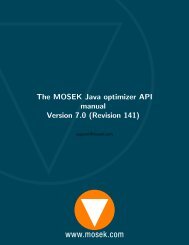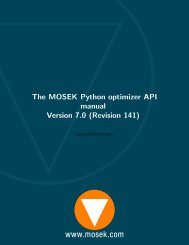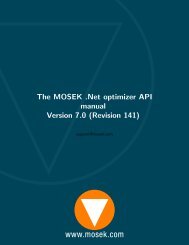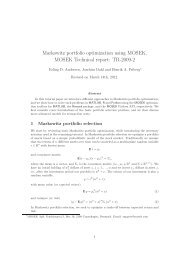- Page 1 and 2:
The MOSEK command line tool. Versio
- Page 3 and 4:
Contents 1 Changes and new features
- Page 5 and 6:
CONTENTS v 6.5 Termination criterio
- Page 7 and 8:
CONTENTS vii 9.1.56 MSK DPAR NONCON
- Page 9 and 10: CONTENTS ix 9.2.79 MSK IPAR MIO FEA
- Page 11 and 12: CONTENTS xi 9.2.171 MSK IPAR SOL RE
- Page 13 and 14: CONTENTS xiii 11.29 Ordering strate
- Page 15 and 16: CONTENTS xv 18.2 arki001 . . . . .
- Page 17 and 18: Contact information Phone +45 3917
- Page 19 and 20: License agreement Before using the
- Page 21 and 22: Chapter 1 Changes and new features
- Page 23 and 24: 1.4. OPTIMIZATION TOOLBOX FOR MATLA
- Page 25 and 26: Chapter 2 What is MOSEK MOSEK is a
- Page 27 and 28: Chapter 3 MOSEK and AMPL AMPL is a
- Page 29 and 30: 3.6. CONSTRAINT AND VARIABLE NAMES
- Page 31 and 32: 3.8. HOT-START 15 Linear dependency
- Page 33 and 34: 3.10. SENSITIVITY ANALYSIS 17 • .
- Page 35 and 36: Chapter 4 Problem formulation and s
- Page 37 and 38: 4.1. LINEAR OPTIMIZATION 21 be a pr
- Page 39 and 40: 4.2. CONIC QUADRATIC OPTIMIZATION 2
- Page 41 and 42: 4.2. CONIC QUADRATIC OPTIMIZATION 2
- Page 43 and 44: 4.3. SEMIDEFINITE OPTIMIZATION 27 4
- Page 45 and 46: 4.5. GENERAL CONVEX OPTIMIZATION 29
- Page 47 and 48: 4.5. GENERAL CONVEX OPTIMIZATION 31
- Page 49 and 50: Chapter 5 The optimizers for contin
- Page 51 and 52: 5.1. HOW AN OPTIMIZER WORKS 35 5.1.
- Page 53 and 54: 5.2. LINEAR OPTIMIZATION 37 5.2.2 T
- Page 55 and 56: 5.2. LINEAR OPTIMIZATION 39 Wheneve
- Page 57 and 58: 5.2. LINEAR OPTIMIZATION 41 5.2.2.3
- Page 59: 5.2. LINEAR OPTIMIZATION 43 • Rai
- Page 63 and 64: 5.6. SOLVING PROBLEMS IN PARALLEL 4
- Page 65 and 66: Chapter 6 The optimizers for mixed-
- Page 67 and 68: 6.3. THE MIXED-INTEGER CONIC OPTIMI
- Page 69 and 70: 6.5. TERMINATION CRITERION 53 The f
- Page 71 and 72: 6.7. UNDERSTANDING SOLUTION QUALITY
- Page 73 and 74: Chapter 7 The analyzers 7.1 The pro
- Page 75 and 76: 7.1. THE PROBLEM ANALYZER 59 Constr
- Page 77 and 78: 7.2. ANALYZING INFEASIBLE PROBLEMS
- Page 79 and 80: 7.2. ANALYZING INFEASIBLE PROBLEMS
- Page 81 and 82: 7.2. ANALYZING INFEASIBLE PROBLEMS
- Page 83 and 84: 7.2. ANALYZING INFEASIBLE PROBLEMS
- Page 85 and 86: 7.2. ANALYZING INFEASIBLE PROBLEMS
- Page 87 and 88: Chapter 8 Sensitivity analysis 8.1
- Page 89 and 90: 8.4. SENSITIVITY ANALYSIS FOR LINEA
- Page 91 and 92: 8.5. SENSITIVITY ANALYSIS WITH THE
- Page 93 and 94: 8.5. SENSITIVITY ANALYSIS WITH THE
- Page 95 and 96: Chapter 9 Parameters Parameters gro
- Page 97 and 98: 81 • MSK SPAR ITR SOL FILE NAME.
- Page 99 and 100: 83 • MSK DPAR INTPNT NL TOL REL G
- Page 101 and 102: 85 • MSK IPAR LOG MIO. Controls t
- Page 103 and 104: 87 • MSK DPAR INTPNT NL MERIT BAL
- Page 105 and 106: 89 • MSK IPAR INFEAS PREFER PRIMA
- Page 107 and 108: 91 • MSK IPAR SIM SAVE LU. Contro
- Page 109 and 110: 9.1. MSKDPARAME: DOUBLE PARAMETERS
- Page 111 and 112:
9.1. MSKDPARAME: DOUBLE PARAMETERS
- Page 113 and 114:
9.1. MSKDPARAME: DOUBLE PARAMETERS
- Page 115 and 116:
9.1. MSKDPARAME: DOUBLE PARAMETERS
- Page 117 and 118:
9.1. MSKDPARAME: DOUBLE PARAMETERS
- Page 119 and 120:
9.1. MSKDPARAME: DOUBLE PARAMETERS
- Page 121 and 122:
9.1. MSKDPARAME: DOUBLE PARAMETERS
- Page 123 and 124:
9.1. MSKDPARAME: DOUBLE PARAMETERS
- Page 125 and 126:
9.1. MSKDPARAME: DOUBLE PARAMETERS
- Page 127 and 128:
9.1. MSKDPARAME: DOUBLE PARAMETERS
- Page 129 and 130:
9.1. MSKDPARAME: DOUBLE PARAMETERS
- Page 131 and 132:
9.1. MSKDPARAME: DOUBLE PARAMETERS
- Page 133 and 134:
9.2. MSKIPARAME: INTEGER PARAMETERS
- Page 135 and 136:
9.2. MSKIPARAME: INTEGER PARAMETERS
- Page 137 and 138:
9.2. MSKIPARAME: INTEGER PARAMETERS
- Page 139 and 140:
9.2. MSKIPARAME: INTEGER PARAMETERS
- Page 141 and 142:
9.2. MSKIPARAME: INTEGER PARAMETERS
- Page 143 and 144:
9.2. MSKIPARAME: INTEGER PARAMETERS
- Page 145 and 146:
9.2. MSKIPARAME: INTEGER PARAMETERS
- Page 147 and 148:
9.2. MSKIPARAME: INTEGER PARAMETERS
- Page 149 and 150:
9.2. MSKIPARAME: INTEGER PARAMETERS
- Page 151 and 152:
9.2. MSKIPARAME: INTEGER PARAMETERS
- Page 153 and 154:
9.2. MSKIPARAME: INTEGER PARAMETERS
- Page 155 and 156:
9.2. MSKIPARAME: INTEGER PARAMETERS
- Page 157 and 158:
9.2. MSKIPARAME: INTEGER PARAMETERS
- Page 159 and 160:
9.2. MSKIPARAME: INTEGER PARAMETERS
- Page 161 and 162:
9.2. MSKIPARAME: INTEGER PARAMETERS
- Page 163 and 164:
9.2. MSKIPARAME: INTEGER PARAMETERS
- Page 165 and 166:
9.2. MSKIPARAME: INTEGER PARAMETERS
- Page 167 and 168:
9.2. MSKIPARAME: INTEGER PARAMETERS
- Page 169 and 170:
9.2. MSKIPARAME: INTEGER PARAMETERS
- Page 171 and 172:
9.2. MSKIPARAME: INTEGER PARAMETERS
- Page 173 and 174:
9.2. MSKIPARAME: INTEGER PARAMETERS
- Page 175 and 176:
9.2. MSKIPARAME: INTEGER PARAMETERS
- Page 177 and 178:
9.2. MSKIPARAME: INTEGER PARAMETERS
- Page 179 and 180:
9.2. MSKIPARAME: INTEGER PARAMETERS
- Page 181 and 182:
9.2. MSKIPARAME: INTEGER PARAMETERS
- Page 183 and 184:
9.2. MSKIPARAME: INTEGER PARAMETERS
- Page 185 and 186:
9.2. MSKIPARAME: INTEGER PARAMETERS
- Page 187 and 188:
9.2. MSKIPARAME: INTEGER PARAMETERS
- Page 189 and 190:
9.2. MSKIPARAME: INTEGER PARAMETERS
- Page 191 and 192:
9.2. MSKIPARAME: INTEGER PARAMETERS
- Page 193 and 194:
9.2. MSKIPARAME: INTEGER PARAMETERS
- Page 195 and 196:
9.2. MSKIPARAME: INTEGER PARAMETERS
- Page 197 and 198:
9.2. MSKIPARAME: INTEGER PARAMETERS
- Page 199 and 200:
9.2. MSKIPARAME: INTEGER PARAMETERS
- Page 201 and 202:
9.2. MSKIPARAME: INTEGER PARAMETERS
- Page 203 and 204:
9.2. MSKIPARAME: INTEGER PARAMETERS
- Page 205 and 206:
9.2. MSKIPARAME: INTEGER PARAMETERS
- Page 207 and 208:
9.2. MSKIPARAME: INTEGER PARAMETERS
- Page 209 and 210:
9.2. MSKIPARAME: INTEGER PARAMETERS
- Page 211 and 212:
9.3. MSKSPARAME: STRING PARAMETER T
- Page 213 and 214:
9.3. MSKSPARAME: STRING PARAMETER T
- Page 215 and 216:
9.3. MSKSPARAME: STRING PARAMETER T
- Page 217 and 218:
9.3. MSKSPARAME: STRING PARAMETER T
- Page 219 and 220:
Chapter 10 Response codes Response
- Page 221 and 222:
205 MSK RES ERR CON Q NOT PSD The q
- Page 223 and 224:
207 MSK RES ERR GLOBAL INV CONIC PR
- Page 225 and 226:
209 MSK RES ERR INV MARKJ Invalid v
- Page 227 and 228:
211 MSK RES ERR INVALID FORMAT TYPE
- Page 229 and 230:
213 MSK RES ERR LICENSE NO SERVER S
- Page 231 and 232:
215 MSK RES ERR MIO NO OPTIMIZER No
- Page 233 and 234:
217 MSK RES ERR NAME MAX LEN A name
- Page 235 and 236:
219 MSK RES ERR NUMCONLIM Maximum n
- Page 237 and 238:
221 MSK RES ERR QCON UPPER TRIANGLE
- Page 239 and 240:
223 MSK RES ERR SYM MAT INVALID COL
- Page 241 and 242:
225 MSK RES ERR USER NLO FUNC The u
- Page 243 and 244:
227 MSK RES WRN ANA ALMOST INT BOUN
- Page 245 and 246:
229 MSK RES WRN MIO INFEASIBLE FINA
- Page 247 and 248:
231 MSK RES WRN WRITE DISCARDED CFI
- Page 249 and 250:
Chapter 11 API constants 11.1 Const
- Page 251 and 252:
11.5. PROGRESS CALL-BACK CODES 235
- Page 253 and 254:
11.5. PROGRESS CALL-BACK CODES 237
- Page 255 and 256:
11.5. PROGRESS CALL-BACK CODES 239
- Page 257 and 258:
11.5. PROGRESS CALL-BACK CODES 241
- Page 259 and 260:
11.6. TYPES OF CONVEXITY CHECKS. 24
- Page 261 and 262:
11.10. DOUBLE INFORMATION ITEMS 245
- Page 263 and 264:
11.10. DOUBLE INFORMATION ITEMS 247
- Page 265 and 266:
11.11. FEASIBILITY REPAIR TYPES 249
- Page 267 and 268:
11.13. INTEGER INFORMATION ITEMS. 2
- Page 269 and 270:
11.13. INTEGER INFORMATION ITEMS. 2
- Page 271 and 272:
11.13. INTEGER INFORMATION ITEMS. 2
- Page 273 and 274:
11.17. LANGUAGE SELECTION CONSTANTS
- Page 275 and 276:
11.22. MIXED-INTEGER NODE SELECTION
- Page 277 and 278:
11.29. ORDERING STRATEGIES 261 MSK
- Page 279 and 280:
11.34. PROBLEM STATUS KEYS 263 MSK
- Page 281 and 282:
11.38. SENSITIVITY TYPES 265 MSK SC
- Page 283 and 284:
11.44. SOLUTION ITEMS 267 MSK SIM S
- Page 285 and 286:
11.46. SOLUTION TYPES 269 11.46 Sol
- Page 287 and 288:
11.52. INTEGER VALUES 271 11.52 Int
- Page 289 and 290:
Chapter 12 MOSEK Command line tool
- Page 291 and 292:
12.3. THE PARAMETER FILE 275 -min F
- Page 293 and 294:
Chapter 13 The MPS file format MOSE
- Page 295 and 296:
13.1. MPS FILE STRUCTURE 279 Extens
- Page 297 and 298:
13.1. MPS FILE STRUCTURE 281 [vname
- Page 299 and 300:
13.1. MPS FILE STRUCTURE 283 Field
- Page 301 and 302:
13.1. MPS FILE STRUCTURE 285 Next d
- Page 303 and 304:
13.2. INTEGER VARIABLES 287 13.2 In
- Page 305 and 306:
Chapter 14 The LP file format MOSEK
- Page 307 and 308:
14.1. THE SECTIONS 291 x1 * x2 Ther
- Page 309 and 310:
14.2. LP FORMAT PECULIARITIES 293 1
- Page 311 and 312:
14.3. THE STRICT LP FORMAT 295 MSK
- Page 313 and 314:
Chapter 15 The OPF format The Optim
- Page 315 and 316:
15.2. THE FILE FORMAT 299 [con ’c
- Page 317 and 318:
15.2. THE FILE FORMAT 301 - ‘NEAR
- Page 319 and 320:
15.4. WRITING OPF FILES FROM MOSEK
- Page 321 and 322:
15.5. EXAMPLES 305 [/hints] [variab
- Page 323 and 324:
15.5. EXAMPLES 307 x1 x2 [/integer]
- Page 325 and 326:
Chapter 16 The XML (OSiL) format MO
- Page 327 and 328:
Chapter 17 The solution file format
- Page 329 and 330:
17.2. THE INTEGER SOLUTION FILE 313
- Page 331 and 332:
Chapter 18 Problem analyzer example
- Page 333 and 334:
18.2. ARKI001 317 2 476 45.42 48.19
- Page 335 and 336:
18.4. PROBLEM WITH BOTH LINEAR AND
- Page 337 and 338:
Bibliography [1] R. Fourer and D. M
- Page 339 and 340:
Index AMPL outlev, 13 wantsol, 13 a
- Page 341 and 342:
INDEX 325 MSK RES ERR FEASREPAIR IN
- Page 343 and 344:
INDEX 327 MSK RES ERR MPS NULL VAR
- Page 345 and 346:
INDEX 329 MSK RES TRM MAX TIME, 226


